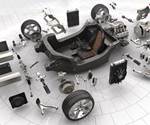McLaren: Multilevel customer support
To address the customer “ownership experience” for its new supercar, the MP4-12C, McLaren Automotive Ltd. (Woking, U.K.) took a three-pronged approach: an intensive engineering and development program that was followed by manufacturing to demanding quality standards, and then an “after-sales safety net” that was designed to ensure an exemplary ownership experience.
To address the customer “ownership experience” for its new supercar, the MP4-12C, McLaren Automotive Ltd. (Woking, U.K.) took a three-pronged approach: an intensive engineering and development program that was followed by manufacturing to demanding quality standards, and then an “after-sales safety net” that was designed to ensure an exemplary ownership experience. The latter comprises an innovative onboard, trilevel telediagnostics system, plus both technical support managers at the McLaren Technology Centre and a group of regional After Sales zone managers, who received the same training as the technical managers and are available 24/7 to travel anywhere in their region to solve problems with MP4-12Cs. For really challenging problems that can’t be solved with local or regional support, a team from McLaren’s U.K. technical center is available to fly anywhere in the world. The company’s final support mechanism for truly intractable issues is that McLaren will bring the vehicle back to its U.K. headquarters — the same support offered to owners of McLaren’s Formula 1 cars.
The company also expects that its centralized “Dynamic Diagnostics” system will help distinguish legitimate problems from driver errors. Much like OnStar (a subsidiary of General Motors Co., Detroit, Mich.) and similar systems, drivers who think their vehicle has a problem can send a detailed diagnostic message that contains values and error codes from the onboard electronic control unit (ECU) to their nearest McLaren dealer or After Sales zone manager. The company promises a call back from a technical specialist within minutes to confirm whether there is a real issue and, if there is, information on the best course of action to take. The company hopes this combination of electronic and human problem solving will help prevent driver inconvenience by ruling out false alerts and catching real problems early enough to fix them at the least expense. McLaren also promises that every retailer will be supplied with at least one spare part for each component on the vehicle, to expedite repairs.
Mike Sopp, head of aftersales at McLaren Automotive, says, “Despite all the focus on development and production, and our aspirations to build cars that are as reliable, robust and useable as they are exhilarating to drive, we are not so arrogant as to believe that every single car will be completely faultless throughout its life cycle. Owners will be involved in accidents, and some cars will require maintenance, so it is our ambition to ensure that, firstly, our customers are treated better than others; secondly, we resolve issues more effectively than any of our competitors; and thirdly, we get 12Cs back on the road more quickly than our competitors. We know that in the automotive business, customers are, more often than not, more concerned about how issues are resolved, rather than the issue itself… We are not prepared to let poor aftersales support spoil the ownership experience,” he concludes.
Related Content
-
SMC composites progress BinC solar electric vehicles
In an interview with one of Aptera’s co-founders, CW sheds light on the inspiration behind the crowd-funded solar electric vehicle, its body in carbon (BinC) and how composite materials are playing a role in its design.
-
TPI manufactures all-composite Kenworth SuperTruck 2 cab
Class 8 diesel truck, now with a 20% lighter cab, achieves 136% freight efficiency improvement.
-
Composites end markets: Automotive (2024)
Recent trends in automotive composites include new materials and developments for battery electric vehicles, hydrogen fuel cell technologies, and recycled and bio-based materials.

.jpg;width=70;height=70;mode=crop)










